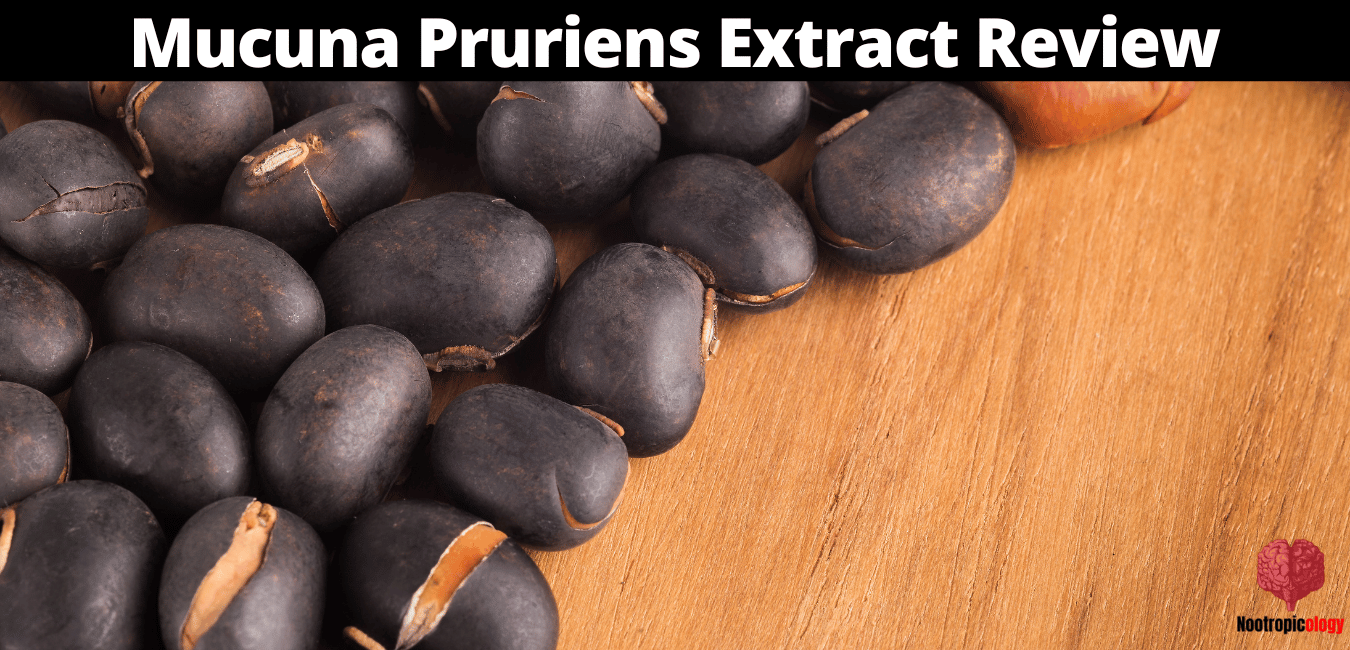Mucuna Pruriens Extract Review: Nootropic Benefits & Side Effects
When it comes to natural remedies that have been celebrated for their medicinal properties, Mucuna Pruriens is a name that resonates through ancient texts and modern research alike.
A tropical legume native to Africa and parts of Asia, this intriguing plant has piqued the interest of wellness aficionados and scientific communities for its potential nootropic benefits. Often referred to as "velvet bean" or "cowitch", Mucuna Pruriens has long been used in traditional medicine for a myriad of health reasons.
But what really stands out is its extract's promising role in cognitive enhancement and mood modulation.
As someone who is constantly on the lookout for natural and effective ways to boost cognitive functions, I was naturally drawn to understand more about this mysterious bean.
In this review, I will delve into the nootropic benefits of Mucuna Pruriens extract and also shed light on its potential side effects.
Dive in with me, as I explore the intriguing world of this age-old remedy.
What is Mucuna Pruriens?


Mucuna Pruriens, commonly known as the velvet bean, cowitch, or kapikacchu, is a tropical legume that belongs to the Fabaceae family. The plant is characterized by its climbing nature, often extending over trees and shrubs.
Its pods are covered with tiny, hair-like bristles that cause severe itching upon contact, a feature that earned it the name "itching bean". When matured, these pods house seeds that have a smooth texture and a black or white coloration.
The natural habitat of Mucuna Pruriens spans across tropical regions, predominantly in Africa and parts of Asia. Over the centuries, it has also been introduced and cultivated in the Caribbean and parts of Central and South America.
Its preference for warm climates and ability to thrive even in less-than-ideal soils has made it a widespread species in these regions.
Main Constituents of the Extract
The true power of Mucuna Pruriens lies in the chemical compounds found within its seeds.
The most notable and researched constituent is L-DOPA (Levodopa), a naturally occurring amino acid precursor that plays a significant role in the human nervous system (CNS).
- L-DOPA (Levodopa): This is the primary active ingredient in the extract of Mucuna Pruriens. L-DOPA is a direct precursor to the neurotransmitter dopamine, which plays a vital role in mood regulation, pleasure, reward, and motor coordination. Due to its significance in dopamine production, L-DOPA derived from Mucuna Pruriens is also studied for its potential benefits in conditions like Parkinson's disease.[1]
- Other Constituents: Beyond L-DOPA, Mucuna Pruriens seeds also contain other bioactive compounds such as serotonin, tryptamine, and nicotine. Additionally, they possess antioxidants, beta-carbolines, and tannins. Each of these compounds can have varied effects on human health and cognition, but it's the synergistic action of all these components that makes Mucuna Pruriens a subject of extensive research and interest.[2]
In the realm of traditional medicine, the seed's extract has been leveraged for its potential benefits for centuries. Modern research continues to probe its depths, seeking to understand its full scope of effects on human health and cognition.
How Does Mucuna Pruriens Work in the Brain?


To appreciate the nootropic effects of Mucuna Pruriens (MP), it's essential to understand its mechanism of action within the brain and the pivotal role L-DOPA plays in this process.
Let's take a closer look into the intricate interplay of compounds, enzymes, and neurotransmitters that bring about the cognitive benefits attributed to this ancient legume.
Mucuna Pruriens's Mechanism of Action (MoA)
- L-DOPA Conversion to Dopamine: At the core of MP's action in the brain is L-DOPA. Once ingested and absorbed into the bloodstream, L-DOPA has the unique ability to cross the blood-brain barrier, a protective shield that prevents many substances from entering and affecting the brain. Once inside the brain, L-DOPA is converted into dopamine, a vital neurotransmitter, by the enzyme aromatic L-amino acid decarboxylase (also known as DOPA decarboxylase).[3]
- Dopamine Regulation: Dopamine is often referred to as the "feel good" neurotransmitter. It plays a pivotal role in a range of brain functions, including mood regulation, pleasure, reward, and motor coordination. By increasing the availability of L-DOPA and subsequently dopamine, MP can potentially enhance these brain functions.
- Antioxidant Properties: Apart from the dopamine pathway, the constituents of MP also exhibit antioxidant properties. These antioxidants can help combat oxidative stress in the brain, which is a factor in cognitive decline and various neurodegenerative conditions.[4]
Nootropic Benefits
While the research is still evolving, the nootropic benefits of MP, mainly attributed to its L-DOPA content, include:
- Mood Enhancement: By increasing dopamine levels, MP can promote feelings of well-being and positivity, potentially acting as a natural mood enhancer.
- Improved Focus and Motivation: Dopamine plays a crucial role in motivation and attention. Elevated levels can aid in better concentration, alertness, and drive.
- Support in Stress Management: Traditional use of MP includes its role as an adaptogen, helping the body cope with stress. Dopamine regulation can potentially mitigate the effects of chronic stress and promote resilience.[5]
- Potential Neuroprotective Effects: By combating oxidative stress and regulating dopamine, MP might offer protection against certain neurodegenerative conditions, although more research is needed in this area.
The idea that this legume, used traditionally for ages, contains L-DOPA—a precursor to the "feel good" neurotransmitter dopamine—is compelling.
Furthermore, the antioxidant properties of MP offer an added layer of intrigue. In a world where we're constantly battling external stressors, the idea that a natural substance can help combat oxidative stress in the brain is reassuring. I can't help but appreciate the potential this might have in promoting long-term brain health.
Considering its nootropic effects, from mood enhancement to stress management, I see why MP has been revered in traditional medicine.
With that said, let's take a closer look at the nootropic benefits below.
Additional Health Benefits of Mucuna Pruriens (MP)
While the nootropic effects of Mucuna Pruriens are undoubtedly captivating, its health benefits extend far beyond the realm of cognition.
From bolstering male fertility to showcasing promise in treating neurodegenerative diseases, let's explore some of these additional health benefits.
Supports Male Fertility
One of the most heralded benefits of MP in traditional medicine has been its role in supporting male fertility. Modern research aligns with this traditional viewpoint. A clinical trial found that MP supplementation led to improved sperm count and motility in infertile men.[6]
Potential Parkinson's Disease Treatment
Parkinson's disease is a neurodegenerative condition characterized by a decline in dopamine-producing neurons in the brain. This decline leads to the hallmark symptoms of Parkinson's: tremors, rigidity, and bradykinesia (slow movement). L-DOPA, being a direct precursor to dopamine, has been a cornerstone of Parkinson's treatment for decades. Synthetic L-DOPA is commonly prescribed to help replenish dopamine levels in the brain, alleviating some of the disease's symptoms.[7]
Given that Mucuna Pruriens is a natural source of L-DOPA, there's growing interest in its potential role in treating Parkinson's.
A double-blind, randomized, controlled, crossover study published in Clinical Trial Neurology (2017, Aug 1;89(5):432-438) titled "Mucuna pruriens in Parkinson disease" led by Roberto Cilia and team aimed to understand if Mucuna pruriens (MP) could serve as an alternative levodopa source for indigent Parkinson's disease (PD) patients who might not afford long-term therapy with standard levodopa preparations.[8]
In this study, 18 patients with advanced PD underwent various treatments in a randomized sequence. These treatments included standard dispersible levodopa combined with dopa-decarboxylase inhibitor benserazide (LD+DDCI), high-dose MP (MP-Hd), low-dose MP (MP-Ld), a pharmaceutical variant of LD without DDCI, MP plus benserazide (MP+DDCI), and a placebo.
The primary efficacy outcomes examined were changes in motor response at intervals of 90 and 180 minutes and the overall duration of the 'on' state. Additionally, the study also assessed safety measures such as any adverse events, fluctuations in blood pressure and heart rate, and the severity of dyskinesias.
The results indicated that when juxtaposed with LD+DDCI, MP-Ld demonstrated comparable motor responses but with fewer dyskinesias and adverse events. Notably, MP-Hd yielded enhanced motor improvements at both 90 and 180 minutes, an extended 'ON' duration, and reduced dyskinesias. Furthermore, MP-Hd was associated with fewer adverse events than both LD+DDCI and LD-DDCI, and no cardiovascular response discrepancies were identified between the groups.
The study concluded that a single-dose MP administration effectively met all noninferiority efficacy and safety benchmarks when compared to the reference treatment of dispersible levodopa/benserazide. Moreover, the clinical effects of the high-dose MP closely mirrored those of levodopa alone at an equivalent dosage, but with a more advantageous tolerability profile.
This highlights the potential of Mucuna Pruriens as a valuable alternative in PD treatment.
Side Effects and Precautions of Mucuna Pruriens


While the therapeutic potential of Mucuna Pruriens (MP) is vast and promising, it's essential to approach its use with a comprehensive understanding of its side effects and necessary precautions.
Like any potent substance, MP's benefits come with potential risks that vary based on dosage, individual physiology, and external factors.
In this section, we'll delve into the common side effects, crucial drug interactions, contraindications, and the significance of proper dosage to ensure safe and effective consumption of MP.
Common Mucuna Pruriens Side Effects
Mucuna Pruriens, while largely well-tolerated, can give rise to certain side effects, particularly when consumed in excess or in susceptible individuals. Some of the common side effects associated with its consumption include:
- Nausea: As MP increases dopamine levels, it might sometimes disturb the gastrointestinal tract, leading to nausea. This is particularly prevalent when taken on an empty stomach.
- Hallucinations: Excessive dopamine can stimulate certain pathways in the brain that result in hallucinations.
- Insomnia: Dopamine is also involved in the sleep-wake cycle, and imbalances can cause disturbances in sleep patterns.
- Digestive Upset: Some users might experience abdominal cramps, bloating, or diarrhea, especially if sensitive to certain plant compounds present in MP.
- Mood Changes: Overconsumption can lead to rapid mood shifts, including anxiety or irritability.
Interactions with Medications
MP's active compounds, especially L-DOPA, can interact with certain medications. Among the most notable interactions are:
- Monoamine Oxidase Inhibitors (MAOIs): Consuming MP alongside MAOIs can lead to a dangerous spike in serotonin and dopamine, potentially causing serotonin syndrome, a life-threatening condition.
- Antihypertensive Drugs: MP might enhance the effects of blood pressure-lowering drugs, leading to excessive reductions in blood pressure.
- Antipsychotic Medications: Given that many antipsychotic drugs function by modulating dopamine levels, MP can counteract or exacerbate their effects.
Also, it's important to note that certain conditions or situations warrant caution or even avoidance of MP:
- Pregnancy and Breastfeeding: The safety of MP in pregnant or breastfeeding women hasn't been adequately researched. It's advisable to abstain from its consumption during these periods.
- Cardiovascular Disorders: Those with certain heart conditions should consult with healthcare providers before starting MP, as it might influence blood pressure and heart rate.
- Mood Disorders: Given MP's effect on neurotransmitters, individuals with mood disorders like bipolar disorder should approach its use with caution.
Overall, while Mucuna Pruriens offers a myriad of potential health benefits, it's of paramount importance to approach its use with informed caution. Always consult with healthcare professionals before integrating MP or any other potent supplement into one's routine.
Nootropic Dosage and How to Take Mucuna Pruriens
Navigating the world of nootropic supplements can be tricky, especially when determining the right dosage.
When it comes to Mucuna Pruriens (MP), the recommended dosage varies based on individual needs and the specific purpose of consumption.
Let's delve into the optimal ways to take MP to ensure its effectiveness and safety.
Recommended Mucuna Pruriens Dosages Based on Current Research:
- Standard Dosage: Most studies and supplement labels suggest a standard dosage range of 200-500 mg of Mucuna Pruriens extract per day. However, this can vary based on the L-DOPA content in the specific product.
- Parkinson's Treatment: In cases of Parkinson's Disease treatment, where MP acts as a natural source of L-DOPA, dosages might be higher and should always be administered under the supervision of a healthcare professional.
- Mood Enhancement & Nootropic Use: A dosage of 100-300 mg daily, preferably split into two doses, is often recommended. Starting on the lower end and adjusting based on individual responses is prudent.
Forms Available:
- Capsules: A convenient form for those who dislike the taste or texture of powders. They provide consistent dosages and are easy to transport.
- Powders: Offers flexibility in dosage and can be mixed with drinks or food. Some prefer this for its more immediate absorption.
- Tinctures & Liquid Extracts: These can provide rapid absorption and can be mixed into beverages.
- Raw Seeds: While some opt to consume raw or roasted seeds, it's crucial to note that they can cause significant irritation if not prepared correctly.
Tips for Safe Consumption:
- Start Slow: If you're new to MP, begin with a lower dose to see how your body reacts before gradually increasing it.
- Consistent Timing: Try to take MP at the same time daily to ensure consistent levels in the body.
- With Food: To prevent potential stomach upset, consider taking MP with a meal or snack.
- Monitor for Side Effects: Keep an eye out for any unusual symptoms or reactions, especially during the initial phase of consumption.
Nootropic Stacks & Dosages:
When it comes to boosting cognitive function, some users prefer to combine (or "stack") MP with other nootropics. Common combinations include:
- MP + Rhodiola Rosea: Rhodiola can enhance the mood-lifting effects of MP and offers added adaptogenic benefits.
- MP + L-Theanine: Often found in tea, L-Theanine can counteract potential jitteriness or anxiety from MP while enhancing focus.
- MP + Bacopa Monnieri: Bacopa may support memory and cognitive function, complementing MP's mood-enhancing effects.
- Standard Dosage: For cognitive enhancement and mood support, the general recommended dosage of MP extract usually falls within the range of 100-300 mg daily. This is based on extracts standardized to around 15% L-DOPA, which equates to about 15-45 mg of L-DOPA per dose.
- Starting Dosage: If you're new to MP, or any nootropic for that matter, it's prudent to begin with the lowest recommended dosage (or even half that) to observe how your body reacts.
I recommend that you approach the use of Mucuna Pruriens and other nootropics with caution and mindfulness. Always start with the lowest effective dose to assess your individual response and gradually adjust based on your observations. While research provides general guidelines, every individual's body and brain chemistry are unique, and what works for one person might not necessarily work for another.
Furthermore, consider keeping a journal to document your dosages, timings, and any effects (both positive and negative) you observe. This can be invaluable in fine-tuning your regimen and identifying patterns over time.
Cycling can also be crucial. Consistent, long-term use of many nootropics can lead to tolerance, making the substance less effective. It can also increase the risk of side effects. By cycling, you give your body a chance to reset, ensuring that the nootropic remains effective when you use it.
Frequently Asked Questions (FAQ)
Is Mucuna Pruriens the same as synthetic L-DOPA used in medications?
While MP is a natural source of L-DOPA, it's not the same as the synthetic form found in medications. MP contains other compounds and bioactives, which might alter its overall effect.
How soon can I expect to feel the effects of Mucuna Pruriens?
Many users report feeling the effects within 30 minutes to an hour after consumption. The impact might vary based on the individual and the specific dosage.
Can you take Mucuna Pruriens everyday?
It is generally recommended to cycle its use. This cycling practice helps prevent the buildup of tolerance and minimizes potential side effects. Continuous daily intake, especially in high doses, might lead to an imbalance in neurotransmitter levels and other side effects. A common cycling recommendation is to take MP for 5 days and then have a 2-day break.
What is the half-life of Mucuna Pruriens?
The half-life of Mucuna pruriens seed extract in effervescent powder form is approximately 112 days when stored at 4°C.
My Final Thoughts on Mucuna Pruriens as a Nootropic
Having delved deeply into the world of Mucuna Pruriens and its nootropic applications, I'm left with a sense of cautious optimism.
This ancient plant, revered in traditional medicine, undoubtedly holds a wealth of potential, especially given its rich L-DOPA content. The connection between L-DOPA, dopamine, and cognitive enhancement is compelling, and there's a real allure in using a natural source for such benefits.
Yet, like any substance we introduce into our bodies, it's imperative to approach MP with respect and a measure of caution. Its effects on mood and cognition, while promising, aren't universally experienced. The fact that it can have such pronounced impacts on the dopamine system means that its balance between benefits and potential side effects is delicate.
As with many nootropics, one person's cognitive enhancer might be another person's source of discomfort or dysphoria.
The research, especially the clinical trial on Parkinson's patients, further underscores MP's potential, but also its complexity. The broader neuroprotective possibilities of MP, beyond just its L-DOPA content, are intriguing. Yet, the full spectrum of its effects, interactions, and long-term implications remains to be comprehensively understood.
If I were to consider Mucuna Pruriens as a staple in my nootropic toolkit, I'd prioritize a few principles:
- Individualization: Start slow, listen to my body, and adjust accordingly.
- Research and Consultation: Continually stay updated on new research and always consult with healthcare professionals.
- Holistic Approach: Remember that nootropics are just one tool in cognitive enhancement. Sleep, diet, exercise, and mindfulness practices play equally, if not more, crucial roles in brain health.
All in all, Mucuna Pruriens shines as a testament to nature's wonders. As a nootropic, it offers a natural bridge to enhanced mood and cognition. But like crossing any bridge, one should tread carefully, enjoy the journey, and be aware of the surroundings.
Until next time,
John Bartholdi
- Lampariello, Lucia Raffaella et al. “The Magic Velvet Bean of Mucuna pruriens.” Journal of traditional and complementary medicine vol. 2,4 (2012): 331-9. doi:10.1016/s2225-4110(16)30119-5 ↑
- Pathania, Ruhi et al. “An assessment of potential nutritive and medicinal properties of Mucuna pruriens: a natural food legume.” 3 Biotech vol. 10,6 (2020): 261. doi:10.1007/s13205-020-02253-x ↑
- Pulikkalpura, Haridas et al. “Levodopa in Mucuna pruriens and its degradation.” Scientific reports vol. 5 11078. 9 Jun. 2015, doi:10.1038/srep11078 ↑
- Dhanasekaran, Muralikrishnan et al. “Antiparkinson drug--Mucuna pruriens shows antioxidant and metal chelating activity.” Phytotherapy research : PTR vol. 22,1 (2008): 6-11. doi:10.1002/ptr.2109 ↑
- Shukla, Kamla Kant et al. “Mucuna pruriens Reduces Stress and Improves the Quality of Semen in Infertile Men.” Evidence-based complementary and alternative medicine : eCAM vol. 7,1 (2010): 137-44. doi:10.1093/ecam/nem171 ↑
- Shukla KK, Mahdi AA, Ahmad MK, Shankhwar SN, Rajender S, Jaiswar SP. "Mucuna pruriens improves male fertility by its action on the hypothalamus-pituitary-gonadal axis." Fertil Steril. 2009 Dec;92(6):1934-40. doi: 10.1016/j.fertnstert.2008.09.045. Epub 2008 Oct 29. PMID: 18973898. ↑
- Tambasco, Nicola et al. “Levodopa in Parkinson's Disease: Current Status and Future Developments.” Current neuropharmacology vol. 16,8 (2018): 1239-1252. doi:10.2174/1570159X15666170510143821 ↑
- Cilia, Roberto et al. “Mucuna pruriens in Parkinson disease: A double-blind, randomized, controlled, crossover study.” Neurology vol. 89,5 (2017): 432-438. doi:10.1212/WNL.0000000000004175 ↑
